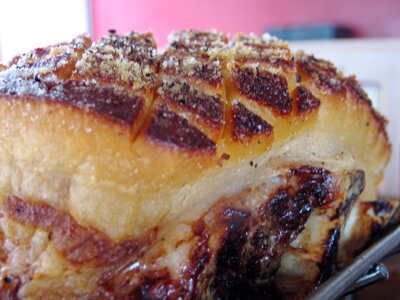Pig, part two of three and a half
The photo has nothing to do with this entry, but it was delicious, and it got you to look. It’s a toss up as to which was better – that roast, an entire shoulder, skin and all, with nothing but salt and pepper, or the sausages we made after eating it. Sausages are to Germany as cheeses are to France – over a thousand varieties exist, with marked regional variation. With diversity come regional styles and regional pride – but for Torsten, all this is a matter of fact. Being from the north, he eats like a northerner (potatoes rather than dumplings or noodles), and knows the recipes of his region, but feels no need to play the partisan, merely impressing upon us that his wurst are not representative of all Germany.
Most sources will describe three major types of wurst – but this is like saying that cheeses are either soft, firm, or blued. Bruhwurst are raw meat, parboiled and smoked, and from this category come frankfurters, wieners (originally wienerwurst), and bierschinken, which is very similar to mortadella. Often, they were made with ice as an ingredient – to counter the heat generated by older, less efficient means of chopping and grinding. Today water is added instead, to make up the volume. Rohwurst are raw meat, fermented and dried, akin to salame and other familiar Italian sausages, sliced uncooked for eating. The idea of fermented meat sounds more alarming than it actually is – most dry sausages (think salame, chorizo, Chinese sausages, and anything which looks similar) are fermented, by some of the same bacteria that ripen cheese (the environments are very similar, both being salty and anaerobic), and the sour tang a vital part of their flavour. The ingredients for kochwurst are fully cooked, and the sausages themselves poached again, the most prominent sausages of this sort being liverwurst and blutwurst.
Both fat and meat were taken from the belly, the long cut between the loin and bacon – the fat, Torsten said, would set up at just the right firmness for spreadable liverwurst after cooking. Skin was set aside for blutwurst – which is basically blood, skin and seasoning. The blood is caught when the pig is slaughtered, then stirred to ensure that it doesn’t coagulate. When mixed with the other ingredients and poached, the blood coagulates and gives the sausage structure. This results in a sausage that is toothsome, full of gelatin from the skin, but smooth as silk, so blutwurst often has cubes of fat, or garlic or onions, or cubes of tongue (zungenblutwurst) embedded in it, to give it texture. Faced with something like twice as much fat as we had lean – itself a relative term, given the beautiful marbling – ours was studded with cubes of fat. Other versions, with cousins all over Europe, are bound with oatmeal, or, farther east, kasha. Most are lightly smoked after poaching, as a flavouring rather than a cure. The fat made them sweet and indefinably rich, the blood made them savoury.
Our liverwurst were fully half fat, with about a third lean and the remainder liver. Fat and meat were boiled together while raw liver was ground, and the still-steaming chunks ground into the liver (think tempering eggs), along with raw Spanish onions. Torsten was quiet on the subject of seasoning – all butchers in Germany are, he says – his uncles did not share their recipes with him, nor would it have been polite of him to ask. After he said that, I felt it would have been inappropriate to ask if he inherited his father’s recipes. One batch of liverwurst, ground butter smooth, tasted of cardamom and cloves. The other, slightly coarser and leaner (the coarser the sausage, the less fat is required for the appropriate tenderness), was ground with herbs then poached in jars, for a slightly rustic pate. Both had enough liver for it to be a distinct presence, like pork foie gras. As with the pigs, such sausages are relics. Sausages used to be one third fat as a matter of course – modernity has made them leaner, and us fatter.
